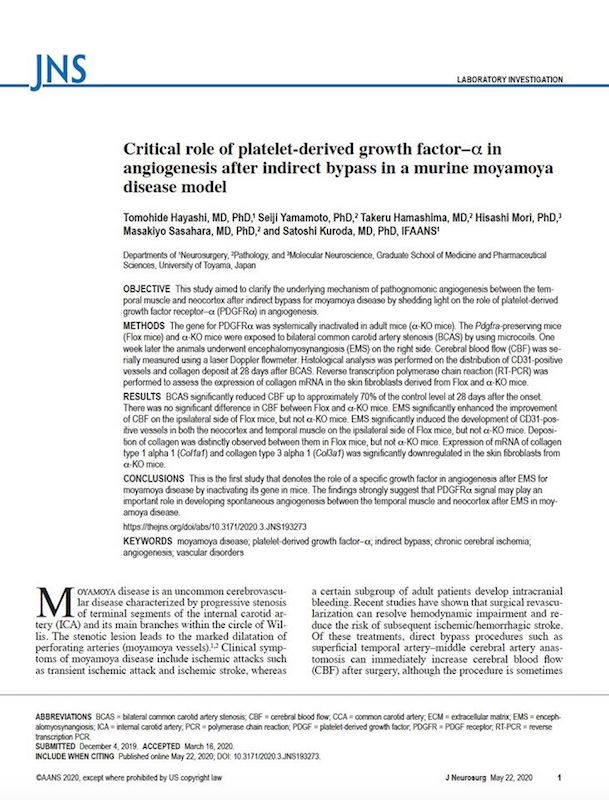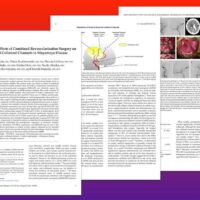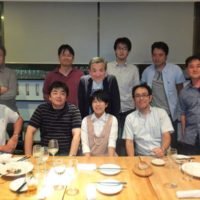
当科の林 智秀先生が大学院生の時に研究した成果がようやく米国脳神経外科学会誌「Journal of Neurosurgery」誌に掲載されました。
もやもや病をシミュレートするため、マウス両側頚動脈高度狭窄モデルを作成して、側頭筋を用いた間接バイパスを実施しました。血小板由来成長因子α受容体(PDGFRα)をノックアウトしたマウスでは、側頭筋と脳表との間でコラーゲン形成、血管新生が抑制されて、脳血流量の回復が妨げられることを世界で初めて証明しました。もやもや病における旺盛な血管新生ではPDGFαがきわめて強力な役割を果たしていることが判明しました。
https://pubmed.ncbi.nlm.nih.gov/32442967/…
A Voyage to Depth of Neuroscience Vol. 71
One of our staffs, Dr. Tomohide Hayashi has published his basic research on moyamoya disease in Journal of Neurosurgery, an official journal of American Association of Neurological Surgeons (AANS).
Tomohide Hayashi, Seiji Yamamoto, Takeru Hamashima, Hisashi Mori , Masakiyo Sasahara, Satoshi Kuroda
Critical Role of Platelet-Derived Growth Factor-α in Angiogenesis After Indirect Bypass in a Murine Moyamoya Disease Model
J Neurosurg. 2020 May 22;1-9. doi: 10.3171/2020.3.JNS193273. Online ahead of print.
PMID: 32442967 DOI: 10.3171/2020.3.JNS193273
Abstract
Objective: This study aimed to clarify the underlying mechanism of pathognomonic angiogenesis between the temporal muscle and neocortex after indirect bypass for moyamoya disease by shedding light on the role of platelet-derived growth factor receptor-α (PDGFRα) in angiogenesis.
Methods: The gene for PDGFRα was systemically inactivated in adult mice (α-KO mice). The Pdgfra-preserving mice (Flox mice) and α-KO mice were exposed to bilateral common carotid artery stenosis (BCAS) by using microcoils. One week later the animals underwent encephalomyosynangiosis (EMS) on the right side. Cerebral blood flow (CBF) was serially measured using a laser Doppler flowmeter. Histological analysis was performed on the distribution of CD31-positive vessels and collagen deposit at 28 days after BCAS. Reverse transcription polymerase chain reaction (RT-PCR) was performed to assess the expression of collagen mRNA in the skin fibroblasts derived from Flox and α-KO mice.
Results: BCAS significantly reduced CBF up to approximately 70% of the control level at 28 days after the onset. There was no significant difference in CBF between Flox and α-KO mice. EMS significantly enhanced the improvement of CBF on the ipsilateral side of Flox mice, but not α-KO mice. EMS significantly induced the development of CD31-positive vessels in both the neocortex and temporal muscle on the ipsilateral side of Flox mice, but not α-KO mice. Deposition of collagen was distinctly observed between them in Flox mice, but not α-KO mice. Expression of mRNA of collagen type 1 alpha 1 (Col1a1) and collagen type 3 alpha 1 (Col3a1) was significantly downregulated in the skin fibroblasts from α-KO mice.
Conclusions: This is the first study that denotes the role of a specific growth factor in angiogenesis after EMS for moyamoya disease by inactivating its gene in mice. The findings strongly suggest that PDGFRα signal may play an important role in developing spontaneous angiogenesis between the temporal muscle and neocortex after EMS in moyamoya disease.









